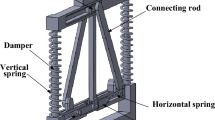Abstract
This paper presents a new method for robust tracking of open loop stable processes using sliding mode control. In this approach, an identified first-order-plus-deadtime model and integro-differential equation as sliding surface is used for sliding mode controller synthesis. The feature of proposed approach is that it shows robustness during desired trajectory tracking in presence of uncertainties and external disturbances. To ensure the stability, tuning parameters of switching control law were derived from Lyapunov stability analysis. Simulation and experimentation studies show that the proposed method is able to provide satisfactory performance compared to some existing methods.










Similar content being viewed by others
References
Bandyopadhyay B, Janardhanan S, Spurgeon SK (2013) Advances in sliding mode control concept, theory and implementation. Springer, Berlin
Eker I (2010) Second order sliding mode control with experimental application. ISA Trans 49(3):394–405
Musmade BB, Patre BM (2015) Design of sliding mode control for time-delay processes. Trans Inst Meas Control 37(6):699–707
Fei J, Batur C (2009) A class of adaptive sliding mode controller with proportional integral sliding surface. Proc Inst Mech Eng, Part I: J Syst Control Eng 223(7):989–999
Talole SE, Kolhe JP, Phadke SB (2010) Extended-state-observer-based control of flexible-joint system with experimental validation. IEEE Trans Ind Electron 57(4):1411–1419
Musmade BB, Patre BM (2013) Feedforward-plus-sliding mode controller design with experimental application of coupled tank system. Trans Inst Meas Control 35(8):1058–1067
Talole S, Phadke S (2002) Height control system for sea-skimming missile using predictive filter. J Guid Control Dyn 25(5):989–992
Camacho O, Smith CA (2000) Sliding mode control: an approach to regulate nonlinear chemical processes. ISA Trans 39(2):205–218
Camacho O, Rojas R, Garcia W (2007) Some long time delay sliding mode approaches. ISA Trans 46(1):95–101
Iglesias MSOCE, Garcia Y, Smith C (2007) Fuzzy surface-based sliding mode control. ISA Trans 46(1):73–83
Chen CT, Peng ST (2005) Design of sliding mode control system for chemical processes. J Process Control 15(5):515–530
Almutairi NB, Zribi M (2006) Sliding mode control of coupled tanks. Mechatronics 16(7):427–441
Kaya I (2008) Performance improvement of unsymmetrical processes using sliding mode control approach. Energ Convers Manag 49(1):101–106
Biswas PP, Srivastava R, Ray S, Samanta AN (2009) Sliding mode control of quadruple tank process. Mechatronics 19(4):548–561
Khandekar AA, Malwatkar GM, Patre BM (2013) Discrete sliding mode control for robust tracking of higher order delay time systems with experimental application. ISA Trans 52(1):36–44
Slotine JJ, Li W (1991) Applied nonlinear control. Prentice Hall, New Jersey
Musmade BB, Patre BM (2012) Design of decentralized sliding mode controllers using dynamic decouplers for TITO processes, In: 12th IEEE international workshop on variable structure systems. IITB, Mumbai, India, pp 105–110
Utkin VI (1997) Control system of variable systems. IEEE Trans Automat Control 22(2):212–222
Fridman L, Moreno J, Iriarte R (2011) Sliding modes after the first decade of the 21st century. Springer-Verlag, New York
Shahraz A, Boozarjomehry R (2009) A fuzzy sliding mode control approach for nonlinear chemical processes. Control Eng Pract 17(5):541–550
Wang QG, Lee TH, Fung HW, Bi Q, Zhang Y (1999) PID tuning for improved performance. IEEE Trans Control Syst Technol 7(4):457–465
Musmade BB, Munje RK, Patre BM (2011) Design of sliding mode controller to chemical processes for improved performance. Int J Control Autom 4(1):15–31
Ansarifar GR, Talebi HA, Davilu H (2012) Adaptive estimator-based dynamic sliding mode control for the water level of nuclear steam generators. Prog Nucl Energ 56:61–70
Musmade B, Patil Y, Munje R, Patre B 2015 Design of sliding mode control scheme for nonlinear processes for improved performance, In: Industrial instrumentation and control (ICIC), 2015 International Conference on, IEEE pp 992–996
Ljung L (1999) System identification: theory for the users. Prentice Hall Inc, New York
Acknowledgments
The authors would like to thank the University of Pune, India for financial support under the Grant UNIPUNE/BCUD/31/0910-0153.
Author information
Authors and Affiliations
Corresponding author
Rights and permissions
About this article
Cite this article
Musmade, B.B., Khandekar, A.A. & Patre, B.M. Sliding mode control design for robust tracking of open loop stable processes with experimental application. Int. J. Dynam. Control 5, 1201–1210 (2017). https://doi.org/10.1007/s40435-016-0273-7
Received:
Revised:
Accepted:
Published:
Issue Date:
DOI: https://doi.org/10.1007/s40435-016-0273-7




